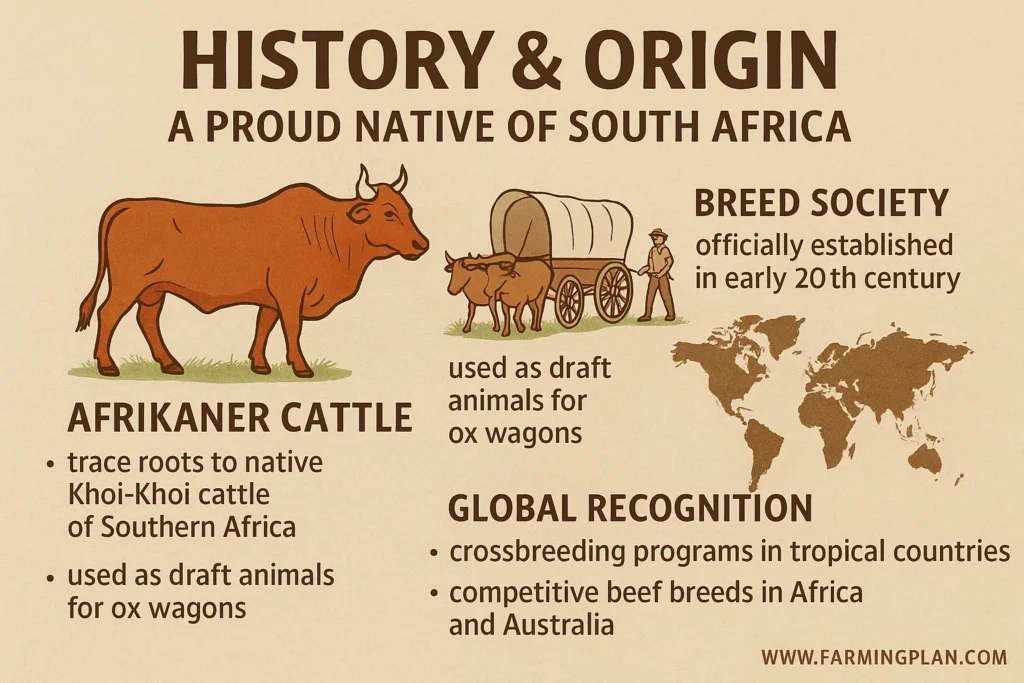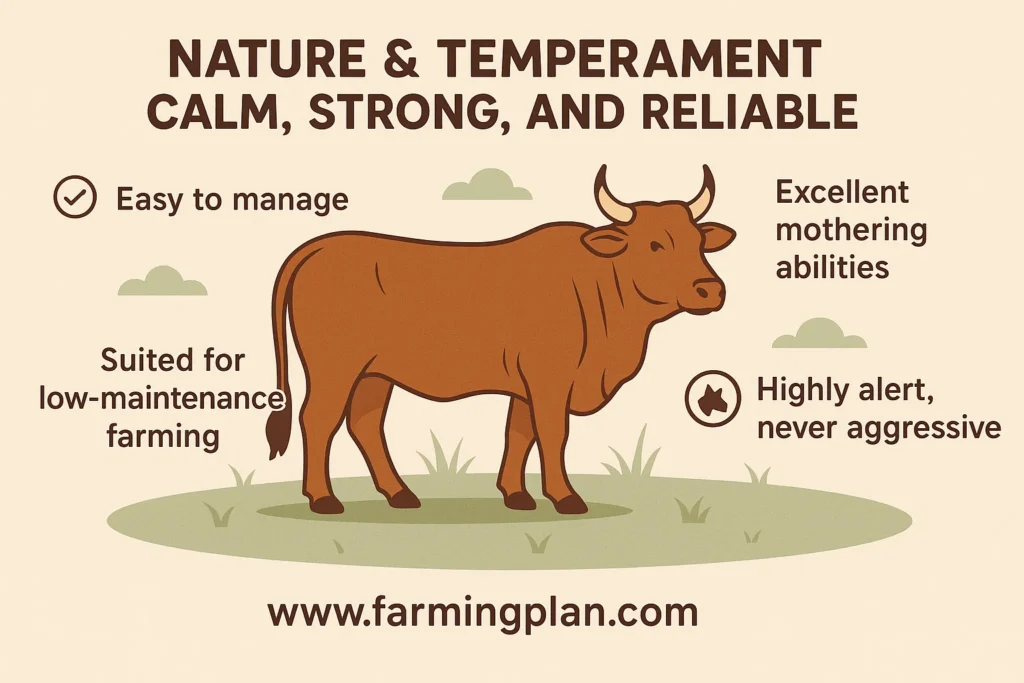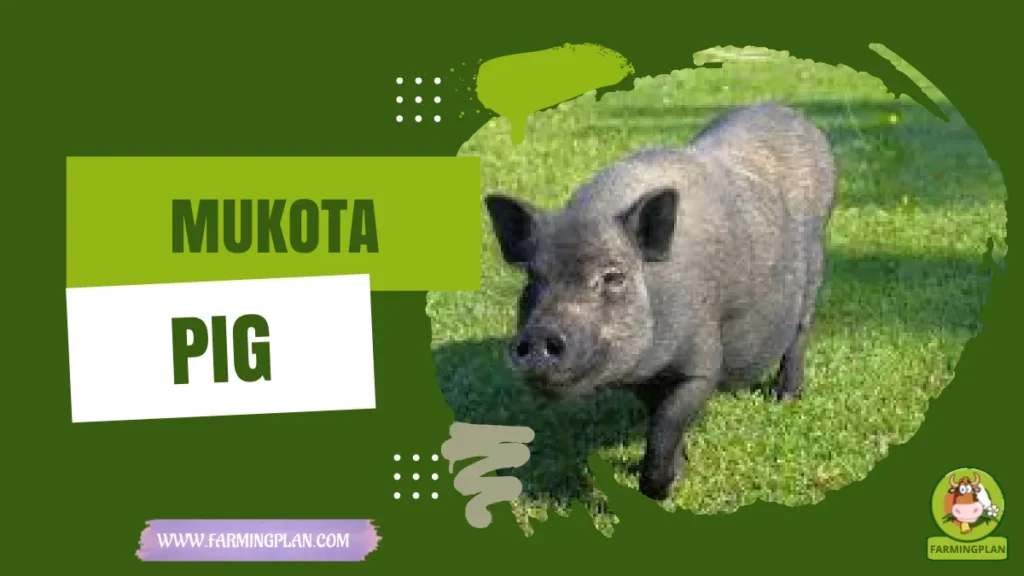Afrikaner Cattle are one of the oldest and most iconic South African cattle breeds. Known for their strength, resilience, and heat resistance, this breed has played a massive role in the history and economy of Southern Africa. Whether you’re raising a herd for beef production or crossbreeding programs or just curious about African livestock breeds, Afrikaner cattle are a name you’ll come across often. I’ve worked with Afrikaners for years now, and I can tell you—they’re a no-nonsense breed built to survive and thrive in harsh conditions. If you’re a farmer, breeder, or livestock enthusiast, keep reading because this elegant breed has plenty to offer.

History & Origin – A Proud Native Of South Africa
Afrikaner Cattle trace their roots back to the native Khoi-Khoi cattle of Southern Africa. These indigenous cattle evolved under some of the toughest environmental conditions in Africa, giving them an unmatched level of hardiness. During British rule, Afrikaner cattle were widely used as draft animals for ox wagons and plowing fields.

The breed society was officially established in the early 20th century, and since then, Afrikaners have gained global recognition. They’ve been part of successful crossbreeding programs in tropical countries and have contributed to creating competitive beef breeds in both Africa and Australia. Their journey from native, functional animals to respected international beef cattle is a real testimony to their quality.
Read More: Angora Goat: The Soft, Curly-Haired Star Of The Fiber World
Characteristics – What Makes Afrikaner Cattle Stand Out
Afrikaner cattle are medium to large-sized animals with a shallow body, muscular build, and a unique hump of muscle over the shoulders. Bulls weigh around 1650–2200 pounds, while cows average 1150–1350 pounds. Their deep cherry red color with amber tips gives them a beautiful, uniform appearance. One of their signature traits is their lateral horns and the thick horn core, giving them a distinctive, majestic look.
Another standout feature is their skin. Afrikaners have active sweat pores and excellent resistance to ticks, making them ideal for hot climate breeds. They’re one of the few African cattle breeds that can hold their own against foreign breeds like Herefords or Shorthorns in both meat production and adaptability.
Nature & Temperament – Calm, Strong, And Reliable
Afrikaner cattle have a calm and steady nature, which makes them easy to manage—even in large herds. In my experience, Afrikaner cows show excellent mothering abilities, making them a reliable choice for breeders. Their temperament is especially suited for farmers who prefer low-maintenance animals that don’t act up easily. This low-maintenance nature of Afrikaner cattle can ease the workload for farmers, allowing them to focus on other aspects of their operations.

They’re also highly alert and responsive but never aggressive. This temperament makes them ideal for both experienced cattlemen and beginners trying their hand in the beef or dairy industry. Whether in private herds or commercial operations, Afrikaners fit in smoothly with herd behavior and farm routines.
Food & Diet – How To Feed Afrikaner Cattle Right
Feeding Afrikaner cattle doesn’t have to be complicated. They’re known to survive and grow well on natural pastures, especially in arid and semi-arid regions. That said, good nutrition helps boost their productive life and meat quality.
Here’s what I recommend:
- Roughage: Natural grass, hay, or silage.
- Protein Supplements: Especially for pregnant cows and bulls during breeding season.
- Mineral Blocks: Essential for bone health and tick resistance.
- Fresh Water: Always ensure easy access, especially in extreme heat.
Avoid overfeeding grain or concentrated feeds as it may affect their digestive system. Balance is key.
Read More: Chinese Owl Pigeon: Graceful Beauty With a Frill of Personality
Usage & Purpose – More Than Just Meat Producers
Afrikaner cattle are mainly bred as a heavy beef-type animal, thanks to their exceptional meat qualities—tenderness, flavor, and high weaning weight. They’re also used in crossbreeding programs with exotic breeds like Brahman for added tick resistance and improved meat production.
Besides being draft animals historically, Afrikaners serve today in:
- Commercial beef farming
- Private herds for breeding
- Crossbreeding for better calf sizes and growth rates
- Smallholder farms looking for hardy livestock
Their adaptability makes them valuable assets in both African and tropical countries.
Special Features – Why Afrikaner Cattle Are Truly Unique
Afrikaner cattle pack in features that are rare in other breeds:
- Extreme Heat Tolerance: Ideal for hot climate farming.
- High Tick Resistance: A natural defense that reduces medication costs.
- Muscle Hump: Adds to carcass weight and value.
- Elegant Colour Uniformity: Deep cherry red is not just pretty—it signals breed purity.
- Low Calf Mortality: Calves are born healthy and strong.
- Long Productive Life: They keep delivering value for many years.
- Excellent Crossbreeding Traits: Improve exotic beef breeds in various climates.
These features make them a reliable, cost-effective, and visually appealing breed for breeders and farmers alike.
“Strong As Africa’s Sun—Afrikaner Cattle Thrive Where Others Struggle!”
Health Issues & Prevention – Keep Them Fit And Thriving
While Afrikaners are hardy and disease-resistant, it doesn’t mean they’re immune to everything. Here are a few things to watch for:

Common Issues:
- Tick-borne Diseases: Despite their resistance, infestations can happen in extreme cases.
- Digestive Upsets: Especially if overfed grain or silage without fiber.
- Heat Stress: In younger calves without shade or water.
- Calf Mortality in Harsh Winters: Rare but preventable with shelter.
Prevention Tips:
- Regular tick control through herbal dips or natural repellents.
- Balanced feeding plans—avoid sudden diet changes.
- Shade and water availability during hot seasons.
- Vaccinations as per regional guidelines.
I always say: observe your herd daily. Early signs often show in behavior long before visible symptoms appear.
Step-by-Step Farming Guide – How To Raise Afrikaner Cattle
Step 1: Set Up Shelter And Grazing Area
Start with a solid fence, clean water supply, and open grazing land. Afrikaners thrive in open fields but still need shaded areas, especially for calves and cows about to give birth. Make sure the land supports native grass species. If your land is arid, consider rotating pastures to avoid overgrazing. Build a simple but strong shelter using local materials—Afrikaners are tough, but they still appreciate a little comfort.
Step 2: Buy From Reputable Sources
Whether you’re looking for an Afrikaner bull for sale or a group of heifers, always go through a registered Afrikaner breed society or trusted farmer. This ensures you’re getting purebred animals with good genetics and vaccination history. Ask for health records, parentage details, and any past issues. This upfront investment saves future headaches.
Step 3: Start With a Balanced Feeding Plan
Use natural grazing as the base. Add supplements for pregnant cows, young calves, and breeding bulls. Don’t forget mineral blocks—they improve immune strength and overall performance. I always recommend giving cattle time to adjust if you’re transitioning from stall feeding to pasture or vice versa.
Step 4: Monitor Breeding & Calving
Afrikaners are a solid calving breed with high fertility rates and low calf mortality. Still, monitor cows during calving seasons. Keep records of bull usage, calving intervals, and calf weights. Tag newborns early, and track weaning weight for commercial decisions.
Step 5: Practice Regular Health Checks
Have a monthly check-up schedule. Deworm, vaccinate, and control ticks. Watch out for signs of stress or lameness. Young calves should be checked weekly during their first two months. Good herd health equals better meat yield, higher weaning weights, and fewer losses.
Expert Tips & Best Practices For Afrikaner Cattle Farming
- Choose quality over quantity when buying your first herd.
- Never ignore water—hydration is critical, especially in arid zones.
- Keep records of feeding, breeding, and health.
- Use crossbreeding wisely—don’t dilute the Afrikaner’s native strengths.
- Join a local or national breed society for expert support and networking.
- Rotate pastures to reduce parasite load and support regrowth.
- Be patient—Afrikaners are slow starters but long-term performers.
FAQs
What is the Afrikaner cattle used for?
Afrikaner cattle are mainly used for beef production and crossbreeding, thanks to their heat resistance, meat quality, and strong maternal instincts.
How much does an Afrikaner bull weigh?
An adult Afrikaner bull usually weighs between 1650 and 2200 pounds, depending on diet and genetics.
Are Afrikaner cattle good for crossbreeding?
Yes, they’re excellent for crossbreeding due to their disease resistance and adaptability to harsh climates.
Do Afrikaner cows produce milk?
Yes, but they are not primarily dairy animals. They produce enough milk to raise healthy calves.
Where can I buy Afrikaner bulls for sale?
You can contact local breeders or Afrikaner breed societies in South Africa and neighboring countries for certified bulls and cows.
Conclusion
Afrikaner cattle aren’t just another beef breed—they’re a living symbol of African strength and resilience. With their exceptional ability to survive in harsh conditions, high-quality meat production, and strong mothering skills, they’re a dream breed for farmers in hot, dry regions. Whether you’re building a commercial herd or just starting out, Afrikaners offer a low-maintenance, high-reward option that adapts well and performs consistently. So if you’re serious about cattle farming, I strongly recommend giving Afrikaner cattle a shot—they might just be the backbone your farm needs.
Ready To Start With Afrikaner Cattle? Join A Local Breed Society, Find A Trusted Seller, And Build Your Herd With Confidence!


